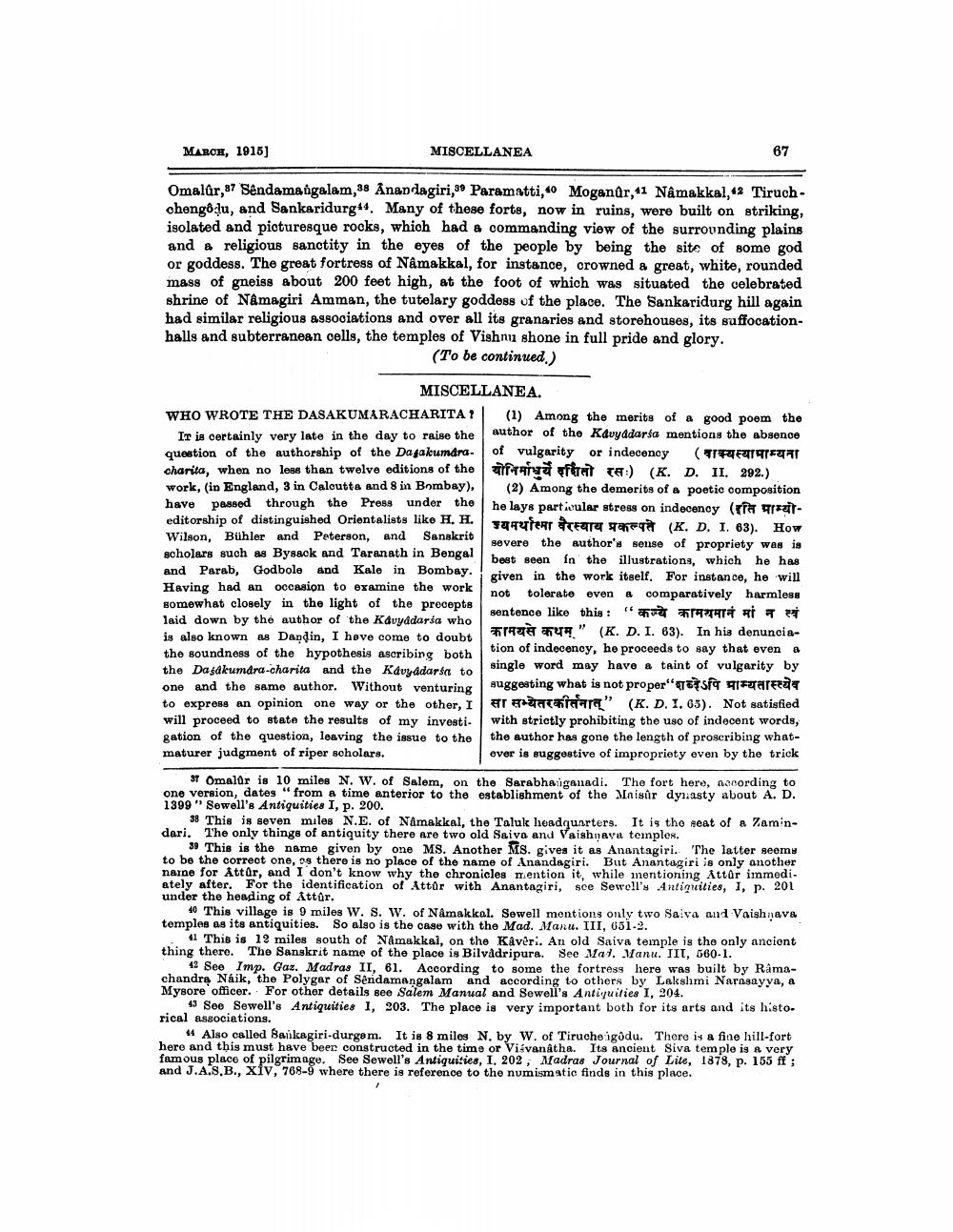________________
MARCH, 1915)
MISCELLANEA
67
Omalar,37 Sendamangalam, 38 Anandagiri,38 Paramatti, Moganar,1 Namakkal,"% Tiruch - chengodu, and Sankaridurg". Many of these forts, now in ruins, were built on striking, isolated and picturesque rocks, which had a commanding view of the surrounding plains and & religious sanctity in the eyes of the people by being the site of some god or goddess. The great fortress of Nâmakkal, for instance, crowned a great, white, rounded mass of gneiss about 200 feet high, at the foot of which was situated the celebrated shrine of Namagiri Amman, the tutelary goddess of the place. The Sankaridurg hill again had similar religious associations and over all its granaries and storehouses, its suffocationhalls and subterranean cells, the temples of Vishnu shone in full pride and glory.
(To be continued)
MISCELLANEA. WHO WROTE THE DASAKUMARACHARITA! (1) Among the merits of a good poem the
IT is certainly very late in the day to raise the author of the Kdvyddarsa mentions the absence question of the authorship of the Dayakumara- of vulgarity or indecency (R a zar charita, when no less than twelve editions of the TAVU aferat TA) (K. D. II. 292.) work, (in England, 3 in Caloutta and 8 in Bombay), (2) Among the demerits of poetic composition have passed through the Press under the
he lays particular stress on indecency (P ha lava nartlar
raiteditorship of distinguished Orientalists like H. H.
Fanyen fear
(K. D. I. 63). How Wilson, Buhler and Peterson, and Sanskrit
severe the author's sense of propriety was is scholars such as Bysack and Taranath in Bengal
best seen in the illustrations, which he has and Parab, Godbole and Kale in Bombay.
given in the work itself. For instance, he will Having had an occasion to examine the work
not tolerate even a comparatively harmless somewhat closely in the light of the precepts
sentence like this: " #A TA #WT laid down by the author of the Kavyddarsa who is also known as Dandin, I have come to doubt
TAYY " (K. D. I. 63). In his denunciathe soundness of the hypothesis ascribing both
tion of indecency, he proceeds to say that even a the Dajakumara-charita and the Kdvyddarsa to
single word may have a taint of vulgarity by one and the same author. Without venturing suggesting what is not proper"शब्नेऽपि माम्यतास्त्येव to express an opinion one way or the other, I T a tara" (K. D. I. 65). Not satisfied will proceed to state the results of my investi. with strictly prohibiting the uso of indecent words, gation of the question, leaving the issue to the the author has gone the length of proscribing whatmaturer judgment of riper scholars.
ever is suggestive of impropriety even by the trick
37 Omalor is 10 miles N. W. of Salem, on the Sarabha iganadi. The fort here, necording to one version, dates " from time anterior to the establishment of the Maisor dynasty about A. D. 1399" Sewell's Antiquities I, p. 200.
38 This is seven miles N.E. of Namakkal, the Taluk headqunrters. It is the seat of a Zamindari. The only things of antiquity there are two old Saiva and Vaishnava temples.
39 This is the name given by one MS. Another Ms. gives it as Anantagiri. The latter seems to be the correct one, os there is no place of the name of Anandagiri. But Anantagiri is only another narne for Attőr, and I don't know why the chronicles mention it, while inentioning Attär immedi. ately after. For the identification of Attúr with Anantagiri, sce Sewell's Antiguities, I, p. 201 under the heading of Attür.
40 This village is 9 miles W. S. W. of Namakkal. Sewell mentions only two Saiva and Vaishnave temples as its antiquities. So also is the case with the Mad. Mart. III, 651.2.
41 This is 12 miles south of Namakkal, on the Kaveri. An old Saiva temple is the only ancient thing there. Tho Sanskrit name of the place is Bilvådripura. See Mal. Manu. III, 560-1.
12 See Imp. Gas. Madras II, 61. According to some the fortress here was built by Ramachandra Naik, the Polygar of Sendamangalam and according to others by Lakshmi Narasayya, a Mysore officer. For other details see Salem Manual and Sewell's Antiquities I, 204.
43 See Sewell's Antiquities 1, 203. The place is very important both for its arts and its histo. rical associations.
14 Also called Bankagiri-durgem. It is 8 miles N. by W. of Tiruchengodu. There is a fine hill-fort here and this must have been constructed in the time or Visvanatha. Its ancient Siva temple is a very famous place of pilgrimage. See Sewell's Antiquities, I. 202, Madras Journal of Lite, 1878, p. 165 ff ; and J.A.S.B., xiv, 708-9 where there is reference to the numismatie finds in this place.




